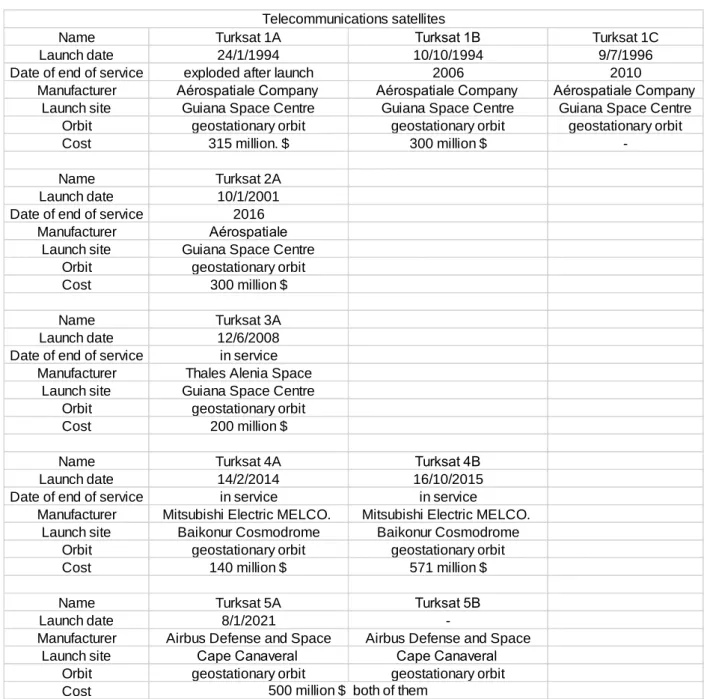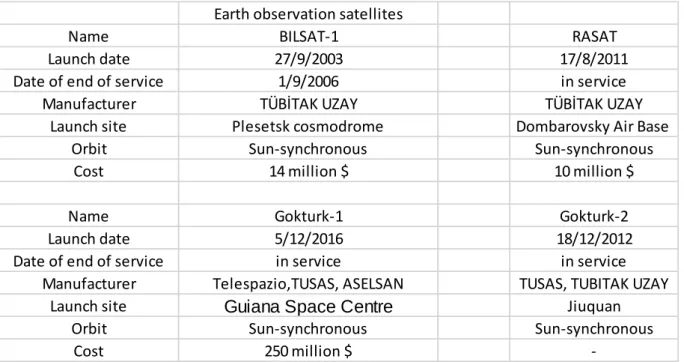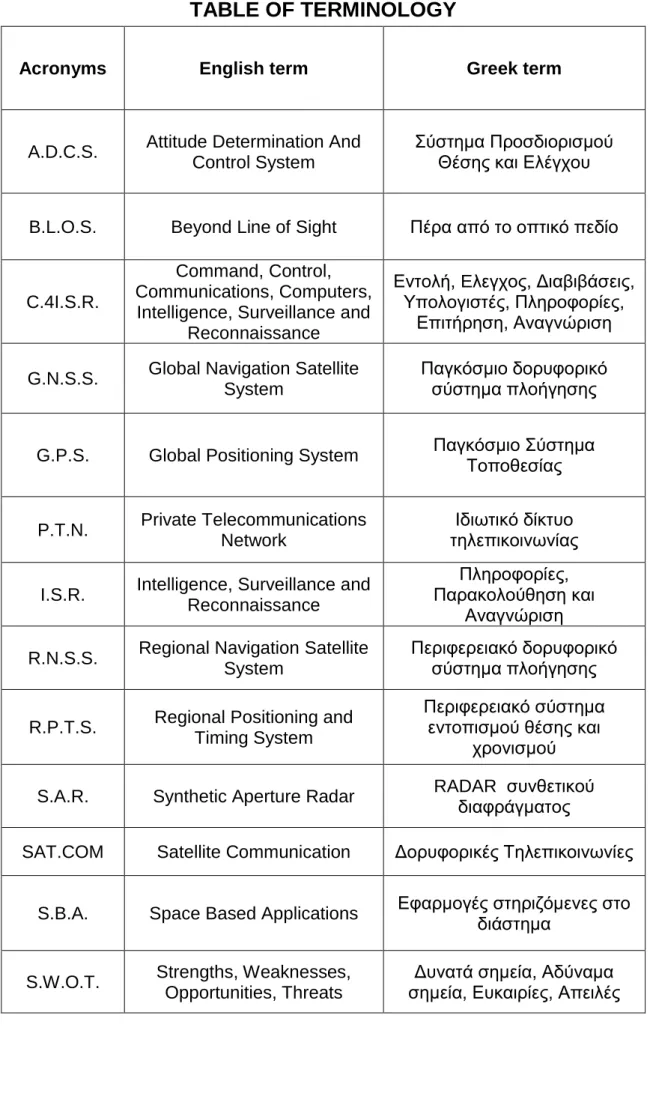As for the needs met by the Turkish space program and what drives the development of space technology, the answer lies in the high demands of the Turkish Armed Forces. Secondly, the high demands of the Turkish Armed Forces, which largely determine Turkey's technological development.
What does space offer? What is its comparative advantage?
The development of the space program is a core policy for Turkey [1], especially for military applications. The armed forces' specialized requirements promote space technology research, while at the same time, the knowledge resulting from the research in turn improves and enhances military applications, which make greater use of the benefits of space technology.
Turkish Space Technology, how did it start and what factors shaped it?
In addition, space provides direct observation of the earth from above, something that can be used for military, agriculture, weather, etc. This is something that will benefit Turkey in its military objectives, which is considered of great importance for the country [9] .
How the first steps in space were taken
The study of coordination of space activities in Turkey officially began with the declaration of the State Planning Agency on June 22, 1990, together with the establishment of the Space Science and Technology Committee (UBITEK) under the auspices of TUBITAK8 [6]. After identifying space (along with defense and aeronautics), a number of specific plans and studies were prepared.
The role of the Turkish Air Force (TAF)
The draft was submitted to the Prime Minister with a statement dated April 28, 1998 from the Ministry of State, to which TUBITAK is responsible. According to its statute, the organization is responsible for the preparation and implementation of a "national space program" determined by the President of Turkey.
Factors that influence the shaping of Turkish space policy
However, the demand for space technology stems from the needs of the Turkish Armed Forces, which is by far the largest and most demanding customer in these matters. We can say that the development of Turkey's space program, especially large-scale projects, is based solely on the requirements of the armed forces, with emphasis on those of the Turkish Air Force.
Turkish policy on the acquisition and supply of Turkish Defense Systems
The main focus of the chapter is decision-making in the defense industry (which contains a very large part of the space program) and how this policy affects the development of domestic industry. It also includes the description of the law 3238/1985 related to the facilitation of the acquisition policy of defense systems.
Policy for the acquisition of defense systems of Turkey
Law 3238/1985
The main goals of this law were to create a modern defense industry that utilizes productive regulatory components and stable cash flows to the defense industry. Furthermore, this law established the "Defense Industry Executive Committee" and the "Defense Industry Support Fund".
Resolution Number 23378
Until then, the state had only the right to the defense industry and private companies were not allowed to enter the defense market. This statute introduced new standards to the defense market, the basic concepts of which were as follows:18.
Space and Security, a different perspective
The need for space to improve a state's security and defense policy: protection of critical
It is therefore clear that, in contrast to old outdated approaches, a primarily precautionary approach to threats will contribute to better and wider security, especially after the spread of global terrorism20, and that the fight against terrorism is not the only threat. to critical space infrastructure [12]. 20 Turkish texts, when talking about terrorism, usually refer to the PKK, Anadolu Agency, accessed 18 April 2021.
Critical services of the Turkish space program
Dependence on space, implications for international politics
As a result, satellites, one of the most significant infrastructures of a country, should be protected, especially those infrastructures related to military and proper operation of the country's services. Turkey's space program began with the acquisition of its first telecommunications satellites by the French private company "Aérospatiale Company" in the early 1990s.
Satellite program of Türksat A.Ş
In this way, Turkey reached the point where the sixth and final generation of the Türksat satellite is being built exclusively in Turkey, at TUSAŞ's facilities at the Space Systems Assembly Integration and Test Center (AIT). In the following subsections we will look at the evolution of telecommunication satellites along with its international partnerships and the main company that manages them.
The first generation of telecommunications satellites
The second generation of telecommunications satellites Türksat 2A
The third generation of telecommunications satellites Türksat 3A
The fourth generation of telecommunications satellites Türksat 4A και Türksat 4B
The fifth generation of telecommunications satellites Türksat 5A και Türksat 5B
It is worth mentioning that while this thesis is being written, Greek and Armenian organizations in the US are trying to cancel the launch of the Türksat 5B30. According to both organizations, the State Department has imposed CAATSA 231 sanctions on both the Turkish Defense Industry and senior Turkish officials.31 Both organizations claim that the Türksat 5B satellite is clearly used for military purposes and is therefore linked to the Turkish Defense Industry.
The sixth generation of telecommunications satellites
Image 5 Coverage area of Türksat 5A in the western channel and Türksat 5B in the spotbeams channel (ka).
Plans for the future
Satellite remote sensing is the applications of this method used in space via satellites. There are many Earth observation remote sensing satellites with different characteristics that produce a variety of satellite data for use in many applications.
BilSAT-1
The transfer of knowledge is necessary, which was also in the contractual conditions. A significant advantage of the project was the experience of the organization implementing it, Surrey Satellite Technologies Limited (SSTL), in terms of knowledge and the ability to transfer that knowledge.
RASAT
Gokturk-1
Delay in delivery of the satellite due to claims from Israel
Israel, which has supplied Thales with some of the key electro-optical components of the high-tech satellite system, has demanded that Gokturk-1 cannot capture images while over its territory42. The French manufacturer initially rejected the request, but was later forced to accept it after the Turkish government threatened to stop payments to the project.
Gokturk-1: a demonstration of capabilities
Figure 9 Satellite image from the GOKTURK-1 satellite of the merchant ship EVERGREEN that was trapped in the Suez Canal in March 2021. press, another "race" took place in the space region.
Gokturk-2
A cooperation agreement for the development of the GOKTURK-2 satellite was signed on April 13, 2007 (before GOKTURK-1) between the Turkish Ministry of National Defense, the TÜBİTAK Institute of Space Technologies (TÜBİTAK UZAY) and the Turkish Aerospace Industry [26]. . Pre-shipment tests of the GOKTURK-2 satellite have been completed at the premises of the Turkish Aerospace Industries (TAI).
Gokturk-3
The goals of the GOKTURK-2 project were, in addition to manufacturing and launching the satellite, further development of the technologically qualified human resources in Turkey and improvement of space infrastructure such as satellite systems to meet the needs of Earth observation needs of public institutions and organizations. However, it seems that significant challenges emerged as the launch of the GOKTURK-3 satellite is delayed and expected between 2025-2028.
The renewal of the satellite Göktürk, Göktürk Yenileme
After the technical studies carried out in this direction, the discussions on the specifications were completed and the Agreement on Advance Planning for the GOKTURK-3 Satellite System Development Project (Phase 1) was signed between SSB and the Turkish Aerospace Industry in May 2013.
Imece: The first earth observation satellite made entirely in Turkey
However, it seems that significant challenges have arisen as the launch of the GOKTURK-3 satellite is delayed and expected in between. In this chapter we look at the space ground station of the BilSat control center and the control center of Istanbul Technical University.
Bilsat’s terrestrial control center
The Satellite Communication and Remote Sensing Center of the Technical University of Turkey was funded by the Central Planning Organization (DPT) in 1996. The purpose of ITU-CSCRS is to develop operational capabilities in satellite remote sensing and satellite telecommunications to meet scientific requirements. and Turkey. operational needs.
The High Resolution Earth Observation microsatellite - LAGARI
The project also includes a cooperation agreement with Berlin Space Technologies GmbH and the satellite will be launched with the PSLV rocket of Indian Antrix Corporation Limited. The PIRISAT project, which is being developed by STM, has as its main objective the implementation of the "Automatic Identification System" (AIS) on small satellites.
ITUpSAT1 satellite
It is named after the Kurd Piri Reis (1470 Gallipoli - 1554 Cairo), who went down in history as a cartographer and admiral of the Ottoman Navy. Image 18 The chassis and interior of the ITUpSat1 satellite. image credit: Pumpkin Inc. and ITU).
TURKSAT-3USAT satellite
BeEagleSat and HAVELSAT scientific satellites
After completing its mission, the satellite has a system to de-orbit and return to Earth in accordance with the applicable microsatellite standard and United Nations regulations. As for the payload of the QB50, the satellite has a multi-link Langmuir Detector (mNLP) and samples the density of electrons around it [45] [46].
UBAKUSAT (UBAK-3U-SAT) satellite
The linear transponder on UBAKUSAT is similar to that on the TURKSAT-3USAT satellite, which was launched in April. The satellite then underwent a series of tests at the space center to simulate the conditions it will face in space.
ASELSAT - high resolution microsatellite
The ASELSAT 3U satellite was launched into space by SpaceX on January 24, 2021, and was placed in a heliosynchronous orbit of 500 km. Under the ASELSAT 3U development program, the Aerospace Engineering Department of Istanbul Technical University (ITU) and the Engineering Department of Atılım University worked as subcontractors.
The Grizu-263 team
Scientific Proposals for a microsatellite program
Telecommunications microsatellites for military applications, operation and general technical
The effectiveness of the formation's communication via satellites is directly proportional to their technical ability to communicate with the existing communication units of the Turkish Armed Forces via air, sea and land [82]. These capabilities are dictated according to the current communication devices (terminals) that potential users already have in order to communicate with all facilities, units and platforms of the Turkish Armed Forces.
Satellite Launch System: Uydu Fırlatma Sistemi
Where are satellites launched from?
A very important fact to note is that the rockets that have been tested are divided into stages, and due to the high altitude a rocket must reach, the first stages of the rocket end up being detached during the launch of the rocket , in the sea. However, due to Turkey's geographical location, such launches are only possible for sun-synchronous orbits.
Space Base in Somalia
In the second phase, planned for 2028, the next mission to the Moon is planned and a smooth landing will be made by spacecraft. Somalia is located on the equator where the centrifugal force of the earth during its rotation is maximum possible.
Regional Positioning and Timing System (RPTS)
Applications and existing implementations of R.P.T.S
However, this is a major problem for developing countries or non-space countries due to the high cost of the systems [58].
Advantages of an independent R.P.T.S. for Turkey
Image 26 The ten points of development of the Turkish Space Program presented by the President of Turkey.
The Turkish Regional Positioning and Timing System (BKZS)
Institute of Space Technologies - TÜBITAK Uzay
The HALE program
The project was completed two years after initial planning in 2018, achieving all of its initial goals.
Defense Industry Executive Committee - SSIK
Defense Industries Presidency - (SSB) Former Ministry of Defense Industries - (SSM)
Plan the production of modern weapons and equipment in both private and public enterprises. Plan the production of required modern weapons and equipment by the private or public sector.
Defense Industry Support Fund
Assists in the research and development of modern weapons and equipment, as well as the construction of prototypes, and has a high degree of financial flexibility. The defense industry presidency is pursuing multibillion-dollar projects and its procurement strategy is focused on domestic production.
Turkish Space Agency - TUA
- The main tasks and responsibilities of the organization
- Improved X-ray synchronization and multimetry - eXTP
- Map of Cosmic Radiation of Turkey - KORAH
- Certification of atomic clock for space use - UTAS-R
The Board of Directors of the Turkish Space Agency has seven members, including the president, and is the highest decision-making body. The presentation of the "National Space Program" was made by the President of the Republic of Turkey in February 2021.
Roketsan
The ROKETSAN MUFA and ROKETSAN SIMSEK missiles were originally designed to be deployed with solid fuel and will be completed in 2023 and 2025. With a possible launch date of 2025, the company is working on propulsion systems, with solid fuels, liquid fuels and hybrids85.
HAVELSAN Co
The HAVELSAN KASK system
HAVELSAN KASK ensures that satellite signals can be analyzed and location information (latitude and longitude) generated correctly when it is blocked by detecting the interfering antenna when it is present and correcting the position accuracy. HAVELSAN KASK is compatible with the existing GNSS system of the Turkish system and can be adapted to the future GNSS.
Aselsan A.Ş
Aselsan Space Technologies
PIU is also tasked with collecting telemetry from the Ku-band and X-Band Payload equipment and sending it to the onboard computer. Ku-Band receiver is in charge of amplifying the received uplink signal and downconverting it to the downlink frequency band.
GUMUSH Aerospace & Defense Ltd
He had the role of project manager on the project, and the purpose of the satellite was to transmit data via voice in low Earth orbit. He also participated in the BEAGLE and HAVELSAT project, which was carried out within the framework of the European research program FP7 in collaboration with three universities in Turkey and the company ErTEK space technology.
Turkish Aerospace Industries – TUSAŞ
Space Systems Assembly Integration and Test (AIT) Center - Uzay Sistemleri, Entegrasyon ve
The space is located within the territory of the Turkish aerospace industry, in the province of Kazan in the province of Ankara. The official inauguration of the facility took place on May 21, 2015 in the presence of President Recep Tayyip Erdogan.
GSATCOM Company
According to the original design, the company aims to produce a satellite in 20 to 24 months and be able to deliver two satellites a year. The construction of the satellites will be flexible and will be able to adapt to the needs, required power, geographic location and transmission beam.
DeltaV A.Ş
Defense Technology and Trade Engineering Company - STM
MICROSATPRO
The space-qualified processor unit (MICROSAPRO)97 is a high-performance on-board computer (OBC) built to suit microsatellite space missions. It is designed to operate in low orbit and is designed to stay in that orbit for at least five years.
NANOSATPRO
Mission Planning Software
The importance Turkey has given to the development of its own space technology and investment in the training of its personnel is evident from the space studies curricula integrated into military academies, as well as from the curriculum provided by the Technical University of Istanbul.
Turkish Air Force Academy
Hezarfen Institute of Aeronautics and Space Technologies (ASTIN)
Turkish Amateur Satellite Technologies Association - TAMSAT
Space Systems Design and Test Laboratory - USTTL
The Objet Eden 500V printer is used to produce samples of industrial prototypes that are in design and will be manufactured. The device enables rapid prototyping in 3 dimensions and thus contributes to the process of product design and development.
Strengths
Given the difficulty and effort required for such a complex long-term project as the Turkish space program, along with the politics that support it, we will present a SWOT (Strengths, Weaknesses, Opportunities, Threats) analysis shortly before closing this dissertation. . In our case, we will try to give a clear picture of the present, future and sustainability of Turkey's space policy and space program [82].
Weaknesses
Opportunities
In addition, the economies of scale that microsatellites bring and their use in applications of various scientific fields give the country the opportunity to gain further experience in space projects at a lower cost, as well as the possibility of exporting these projects [ 82].
Threats
12] Cihan ERCAN, November 2017, “The role of space in the security and defense policy of Turkey. Leloğlu “The Small Satellite Odyssey of Turkey”, TÜBİTAK UZAY (Research Institute for Space Technologies), ODTÜ Kampüsü 06531 Ankara, Turkey.


